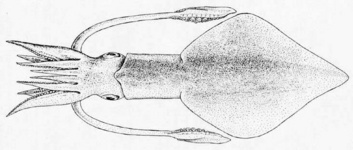Loligo forbesii
Veined squid
Michael Vecchione and Richard E. YoungIntroduction
Maximum mantle length 90 cm in males and 41 cm in females. Off the Azores, length at first maturity is 57 cm in males and 34 cm in females. In the English Channel, the size of summer spawning females is 20 cm and 29 cm in winter spawning females.
Characteristics
- Mantle
- Mantle long, moderately slender, cylindrical.
- Fins
- Fins rhomboidal, their length three quarters that of mantle, their posterior borders slightly concave.
- Arms:
- Largest arm sucker rings with 7 or 8 teeth.
- Left ventral arm hectocotylized in its distal third by modification of suckers into long papillae which gradually decrease in size distally.
- Tentacles
- Suckers on manus of tentacular club subequal in size; sucker rings with 13 to 18 sharp, conical teeth.
Habitat and biology
A species of subtropical and temperate waters (it avoids temperatures below 8.5°C) occurring over the shelf in the temperate part of its distributional range, but found in deeper waters in subtropical areas; the entire depth range extending from about 100 to 400 m.
The population in the northeastern Atlantic is known to carry out seasonal migrations, spending the summer in the North Sea and the eastern part of the English Channel and overwintering in the western part of the Channel. In daytime squids aggregate near the bottom, dispersing at night throughout the water column.
Spawning occurs almost throughout the year in the English Channel, showing a peak in winter (December and January, at temperature of 9 to 11 °C) and another one in summer. The eggs are attached to hard objects on sandy or muddy bottoms; hatching occurs after 30 to 40 days. Juveniles hatched in January and February attain sizes of approximately 11.5 cm in June; by August, the females measure about 14 cm, the males about 15 cm mantle length, and in November about 25 to 30 cm respectively. Both sexes are then mature (the males beginning in October).
Loligo forbesii feeds on small and juvenile fishes, and to a minor extent on other cephalopods, crustaceans, and polychaetes; cannibalism is common. Off the Azores, the most important fish species in their diet is blue jack mackerel (Trachurus picturatus). (Lepidopus caudatus). Other fishes preyed upon include bogue (Boops boops), and silver scabbardfish
Geographical distribution
Eastern Atlantic: 20 °N to 60 °N (excluding the Baltic Sea), Azores Islands, and along west African coast South to the Canary Islands; Mediterranean Sea; southern boundary is unknown. .Other Names for Loligo forbesii
- Veined squid
- Vernacular Names: En: Veined squid, Fr: Encornet veiné, Sp: Calamar veteado, Local species names: Portugal and Azores: Lula.
About This Page

National Museum of Natural History, Washington, D. C. , USA

University of Hawaii, Honolulu, HI, USA
Correspondence regarding this page should be directed to Michael Vecchione at
Page copyright © 2010
 Page: Tree of Life
Loligo forbesii . Veined squid.
Authored by
Michael Vecchione and Richard E. Young.
The TEXT of this page is licensed under the
Creative Commons Attribution-NonCommercial License - Version 3.0. Note that images and other media
featured on this page are each governed by their own license, and they may or may not be available
for reuse. Click on an image or a media link to access the media data window, which provides the
relevant licensing information. For the general terms and conditions of ToL material reuse and
redistribution, please see the Tree of Life Copyright
Policies.
Page: Tree of Life
Loligo forbesii . Veined squid.
Authored by
Michael Vecchione and Richard E. Young.
The TEXT of this page is licensed under the
Creative Commons Attribution-NonCommercial License - Version 3.0. Note that images and other media
featured on this page are each governed by their own license, and they may or may not be available
for reuse. Click on an image or a media link to access the media data window, which provides the
relevant licensing information. For the general terms and conditions of ToL material reuse and
redistribution, please see the Tree of Life Copyright
Policies.
- First online 02 September 2010
- Content changed 02 September 2010
Citing this page:
Vecchione, Michael and Richard E. Young. 2010. Loligo forbesii . Veined squid. Version 02 September 2010 (under construction). http://tolweb.org/Loligo_forbesii/52918/2010.09.02 in The Tree of Life Web Project, http://tolweb.org/









 Go to quick links
Go to quick search
Go to navigation for this section of the ToL site
Go to detailed links for the ToL site
Go to quick links
Go to quick search
Go to navigation for this section of the ToL site
Go to detailed links for the ToL site